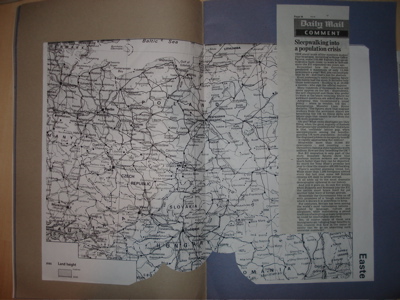Borders

In response to the dead line of a conference Sophie was attending in Athens, some of the Reunion resources were sifted under the theme of “borders” to correspond with that of the lecture. A scrap-book was made, which will continue to be added to. Of course, discussion of borders can be limitless rather than liminal. Its agency as a topic- its currency as a buzz-word might begin to dismantle itself.
What does it mean really for a conference to be based on such a thing? Is it necessary to break these Borders? When are borders useful? In an increasingly globalised art economy, and the increased funding available towards the goal of “cultural exchange” one begins to wonder what all this exchange is based on. And yet it is fruitless to be pessimistic. Perhaps it is best to engage, and observe the ideosyncratic details of such events, helping us to see further the nature of their being. Sophie had a good anecdote about the strangeness of the layout, and the way that since everybody in Athens seems to smoke no one stayed inside to look at scrapbooks and other materials any way.

http://www.aaschool.ac.uk/exhibitions/detail.asp?strID=500&strCateg=current
And yet behind such seeming frivolous moments at private views, other work of real import is made too. I chanced to see some photos and video made by Ioana Marinescu (see image above) when i went to a private view at the Architectural Association by accident. Also by chance met Nada there, which was nice.
I hope to speak to Ioana soon to find out more about her projects and how they might be helpful for my own work. In a sense, I see it as having a relation to similar ideas to the borders conference. She had been working for some time on a piece of research around the erasure of a central area of the city of Bucharest by Ceucescu- both in physical terms, and in terms of memory, for those that were disposessed of their own homes and relocated to the outskirts of the city. This research culminated in an incredibly moving film with personal interviews with previous residents of the area...
Secondly, she showed a set of images of Gas pipe system in Romania. What had been startling for her, on her return to Romania after 10 years, was this example of new growth- the adhoc in the way they were connected. Perhaps it is a sort of reisitence they presented in the face of possible streamlining re-development- unchecked, unregulated in a country still in the process of re-systematising.
That the pipe are always this yellowish colour- signifying this formless power source, a fragile infrastructure, intersecting the plane of the camera frame in an indeosyncratic manner, jutting out across the landscape, both urban and rural, connecting across borders through bizarre twists and alarming elevated short cuts. They made fascinating 3-dimensional drawings, mappings, nestling within everyday life. Creating surprising new borders, whilst disregarding others.